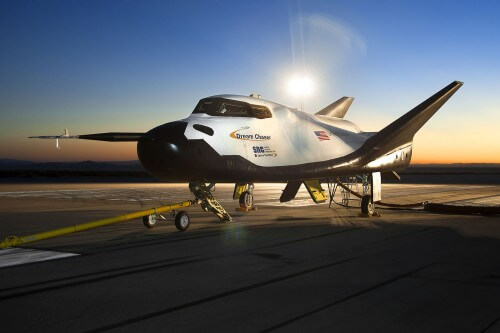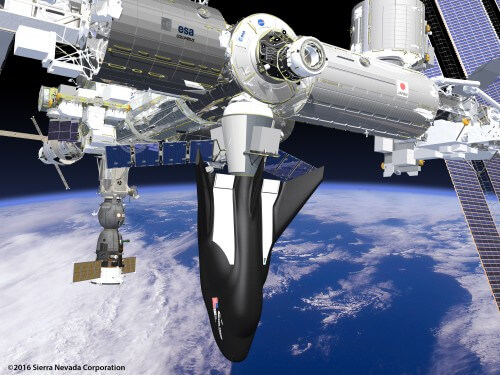NASA announced today that the "Dream Chaser" spacecraft developed by the "Sierra Nevada" company will join the fleet of commercial supply spacecraft to the International Space Station. The announcement was made as part of the announcement of the three winning companies of the CRS-2 program to send supplies and equipment to the station. In addition, the companies that won the previous tender held in 2008, Spice X and Orbital ATK, were re-announced. Two other proposals submitted by the companies Boeing and Lockheed Martin were not selected - even though both have a long experience in the space field.

NASA announced today that the "Dream Chaser" spacecraft developed by the "Sierra Nevada" company will join the fleet of commercial supply spacecraft to the International Space Station. The announcement was made as part of the announcement of the three winning companies of the CRS-2 program to send supplies and equipment to the station. In addition, the companies that won the previous tender held in 2008, Spice X and Orbital ATK, were re-announced.
Sierra Nevada offered the small "Dream Chaser" space shuttle it is developing for the program. The spacecraft is similar to the space shuttles that landed in 2011, although it is much smaller. The planned spacecraft will be launched into space on a regular launcher (Atlas 5), and will return to Earth through a winged landing like a regular airplane.
Originally built for manned missions, Dream Chaser competed in another NASA competition to select spacecraft to launch astronauts to the International Space Station, but lost to SpaceX and Boeing. The company did not give up and changed the purpose of the spacecraft to unmanned delivery missions, and now the decision has paid off with its winning the competition for the current program.
The other two supply spacecraft selected in the program are already routinely sent to the International Space Station - "Cygnus" by OrbitalATK and "Dragon" by SpaceX. NASA will order six missions from each of the three winning companies to be carried out between 2019 and 2024. Since not all the missions from the first program (CRS-1), in which SpaceX and Orbital ATK operate, have yet been completed, supply missions to the station will still be launched until 2019.
Two other proposals submitted by the companies Boeing and Lockheed Martin were not selected - even though both have a long experience in the space field.

A simulation of Dream Chaser docked at the International Space Station. Source: Sierra Nevada Corporation.
One of the considerations that NASA mentioned for the decision to add another spacecraft is the great flexibility that the three different options allow for it. Each spaceship has different capabilities - so that missions for different needs are possible. For example, the Dream Chaser has the ability to return equipment from the space station back to Earth, and unlike it, the Cygnus spacecraft does not have such an ability and burns up in the atmosphere at the end of its mission. SpaceX's Dragon spacecraft does have return capability, but its capsule makes a hard landing on the sea, which could damage delicate scientific experiments being returned from the space station, while Dream Chaser can land with a soft landing like a normal plane.
In addition to this, the recent failures suffered by SpaceX and OrbitalATK emphasized for NASA the necessity of having alternative options. In October 2014, the launch of the Cygnus spacecraft failed, and in June of last year, the Falcon 9 launcher with a Dragon spacecraft on it exploded. These failures were joined by the failure to launch the Russian supply spacecraft Progress in April of last year.
NASA started the CRS (Commercial Resupply Services) program in 2008, against the background of the decision and preparations to land the space shuttles. As part of the program, NASA transferred the responsibility for sending supplies and scientific equipment to the space station to private companies. The program bore its first fruits in October 2012 with the launch of the first commercial supply spacecraft in history - the "Dragon" spacecraft of the SpaceX company. Two years later OrbitalATK joined it with the "Cygnus" spacecraft.
Later, NASA also began a program for the commercial launch of astronauts to the station. The competition was won by SpaceX with the "Dragon" spacecraft in a manned configuration, and the Boeing company with the "Starliner CST-100" spacecraft. According to the current schedule, they are planned to start operating next year.
In NASA's view, these programs are designed to develop the ability of commercial companies to operate on the International Space Station and in the area of near-Earth space (an orbit at an altitude of several hundred kilometers). According to NASA, this is an integral part of what it calls "the journey to Mars" - which will allow it to "break free" from near-Earth space and focus on developing advanced capabilities to operate in distant deep space, such as the Orion spacecraft and the heavy SLS launcher it is developing.

One response
A question for Elisef Kosman. You wrote to me that they are 293 days at the station. How long are they currently at the station as of January 17th?